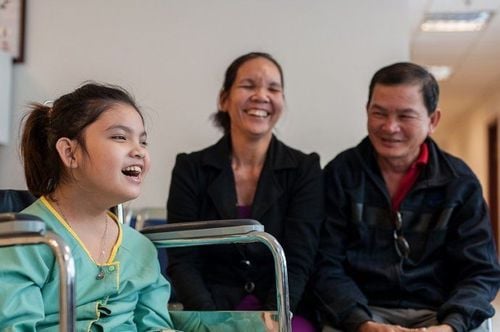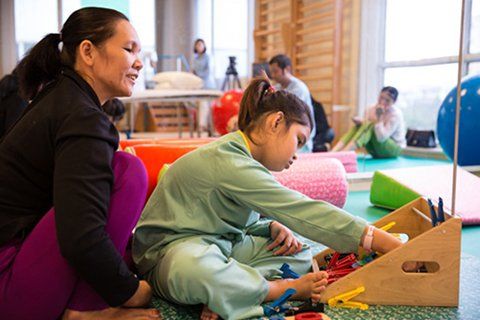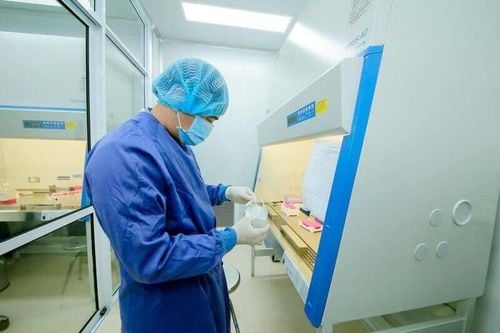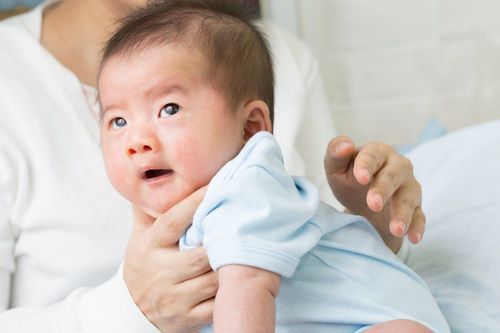This is an automatically translated article.
The article is written by Master, Doctor Vu Duy Chinh - High-tech Unit for Treatment of Cerebral Palsy and Autism - Vinmec Times City International HospitalEach child with cerebral palsy will have difficult problems with different degrees of severity and lightness, different motor and cognitive status, but the goal to be achieved is to help the child progress and develop to the best ability. individuals in daily activities.
1. Feed and drink children with cerebral palsy
Feeding problems can be very complicated for children with cerebral palsy. Children with cerebral palsy are often thin, malnourished due to poor eating, children are often sick, children are stiff all day, which consumes a lot of energy, making children more severely malnourished. An estimated 35% of children with cerebral palsy are malnourished.
Children's eating is always difficult and cannot keep up with the developmental milestones - oral motor compared with normal children. Eating impairment in children with cerebral palsy is a mixed defect classified as a swallowing disorder of neurological origin. Therefore, taking care of children with cerebral palsy is a very necessary and important issue. Children with cerebral palsy need to eat, how to eat to gain weight, not choke, not constipated ... is a question many parents come to see and consult a doctor.

Give children a nutritious diet with a balanced nutritional composition
Protein: Meat, fish, eggs, milk... Glucid: Rice, cereals, potatoes... Lipid: Fat, cooking oil Vitamins, minerals and substances Dietary fiber: Balance the composition of green vegetables, fruits... Give children with cerebral palsy soft, easy-to-digest foods and eat a variety of dishes. For children from the age of weaning, in addition to breast milk, children need to be fed with porridge or milk, if children are poor, need to divide them into many meals, eat many times a day
For children with muscle cramps a lot Difficulty in mouth and tongue movements need training for children to strengthen their mouth muscles and use their tongue more effectively, making it easier for children to eat and drink, and reduce the risk of choking. If the exercise of chewing and swallowing muscles is not successful, the child eats poorly, or vomits, the surgical placement of a gastrostomy tube to feed the child is the solution to consider to ensure adequate nutrition for the child.
The position of holding and feeding is also very important, to create conditions for children to easily swallow food, to avoid choking and vomiting. Holding and supporting the child's head to slightly bend, soften the erector muscle groups, neck muscles, when feeding the child, the food should be brought from the bottom up, to avoid stimulating the child to look backwards.
Positions that facilitate eating:
Sitting position with head and back straight, hands towards the midline, ensuring relaxation, comfort and facilitating eating activities. Keep baby's head and arms bent forward. Always keep food and drinks from the bottom up and from the front. Place the child to sit slightly back to keep his balance, head and back straight (position for the child to sit on the lap facing the mother) For better balance, place the child upright, hips flexed and spread across the mother's thighs (Mother and child sitting opposite)
2. Bathing children with cerebral palsy

Bathing a child with cerebral palsy can often be a stressful time for parents and carers. However, this is also the time period used as a form of therapy for children with cerebral palsy. Along with bathing and scrubbing your baby, you can help him practice speech as well as a range of movement and movement exercises, making it easier for you to achieve multiple daily goals at once.
You can consult a specialist with a rehabilitation doctor, occupational therapy/rehabilitation technician technician the best way to bathe your baby, given your child's specific characteristics and how best to maneuver things so you don't harm yourself. It's important that your child feels safe in the bath and that he's happy and comfortable himself.
Integrating bathing and rehabilitation exercises as hydrotherapy for children with cerebral palsy. This helps children develop sense, balance, exercise in the water environment also helps children relax, relieve muscle spasms, help children move more easily and thereby make motor progress. Look for a baby-friendly bath chair, with a buoyancy system that allows your baby to relax in the bath. When your child is older and heavier, arrange a large enough tub or bath with convenient access to and from the pool to help your child get in or out of the tub. For older children, bathing in a sitting or kneeling position is more convenient. The design of the bathroom floor has a suitable roughness, avoiding slipping when there is water, making it safe to move on the floor so that children are less likely to fall.
3. Let children with cerebral palsy go to the toilet
Going to the toilet in children with cerebral palsy is also a difficult problem. Children with cerebral palsy are often constipated, the number of bowel movements is usually 3 times a week, they cannot walk on their own, but need the support of adults: Massaging the abdomen, stimulating the anus, using enemas, using the hands to support Help remove stool from the child's anus.
Tight muscles often make it impossible for a child to go to the toilet as usual: The child has difficulty pushing, when coordinating the muscles in expelling stool from the anus. Constipation itself also makes children uncomfortable, stimulating and contributes to increased muscle tone in children
Many children with cerebral palsy have tight abdominal muscles, poor muscle tone, or difficulty controlling their bodies. This makes toilet training a difficult challenge. Parents should arrange a suitable diet, laxative and reduce the risk of constipation by eating lots of fruits and vegetables and having a significant amount of fiber, and drinking enough water. In addition, try to make your child a habit of going to the toilet every day at a certain time of the day.
If the above measures don't help your child's constipation, ask your doctor about trying mineral oils, stool softeners, or laxatives. For children who have not had a bowel movement for 2 consecutive days, it is necessary to take the initiative to remove stool from the child's anus, can actively stimulate the anus with an appropriate size bar of soap lubricated with water, enema with honey. Dilute into the anus of the child in the prone position, with the head low. Can assist in removing poop with a parent's finger, gloved mom...
Try to put your child on a potty chair half an hour after a meal, give encouragement, reward him when he can go to the toilet success.
4. Respiratory care
Children with cerebral palsy often have increased sputum production, accompanied by poor swallowing ability, so they often stagnate sputum and drool in the pharynx. In addition, due to poor coordination of muscles in the mouth, pharynx and throat, children have difficulty eating, eating or choking. Therefore, children with cerebral palsy are very susceptible to inflammation of the upper respiratory tract (inflammation of the nose, throat ...), the lower respiratory tract (bronchitis, lung ...). If severe, the child is very susceptible to respiratory failure, which is life-threatening. Parents and caregivers can reduce the risk and inflammation above with the following instructions
When feeding children, drink carefully to avoid choking; Do not give the child food or drink when he is crying or having a hard time.

If the child has difficulty in taking oral food, a nasogastric tube can be considered. When the child has sputum stagnation, it is necessary to put the child in a good position, vibrate, drain the sputum and drool. Strengthen children's resistance: Take the child out, change the environment, avoid staying in the house for a long time Keep the child warm in the winter, cool in the summer, because children with cerebral palsy often stiffen, or sweat a lot Children are susceptible to colds, leading to bronchitis and pneumonia.
5. Caring for children with cerebral palsy and epilepsy
Seizures can cause
Child falls, trauma, accident (for children with cerebral palsy who can stand and walk) May bite tongue, urinate, poop on pants May choke, choke, suffocate Causes Parents, family panic, fear Epilepsy can lead to coma and death. Before the attack: Very unpredictable, it is necessary to pay attention to good health monitoring care for children at home, at kindergarten, in class, at school.
During the crisis
Parents, keep calm. Loosen clothes and diapers Do 5 nos: Do not put anything in the child's mouth; Do not feed or drink; Do not give medicine; Do not pressurize; Do not allow contact with objects on the skin and on the child's body. You can apply ice, warm towels to the forehead, armpits, groin, hands, feet when the child has a fever...
After the attack
Wipe the phlegm widely, wash scratches, change diapers. Take the child to the hospital: Children need to have an EEG for assessment, have an examination book and periodic monitoring Give the child medicine
Epilepsy children must take medicine according to a specialist prescription, according to the following principles
Take it correctly instructions (prescriptions, specialist medical examination and treatment books ...) Drinking regularly and continuously, only stopping the drug according to medical orders, stopping suddenly will make the disease worse. Take your medicine at the right dose, at the right time. Determining to take long-term medication (months, years) Must keep a log to monitor the attacks, preferably a calendar, clearly stating the number of attacks, type of attack, date and time of the attack... Periodic medical examination according to instructions doctor.
6. Sleep for children with cerebral palsy
Children with cerebral palsy often sleep poorly due to brain damage that stimulates the central nervous system, it is necessary to create a quiet and comfortable environment to help children sleep more easily.
Rehabilitation and daily exercise also help children have better and deeper sleep at night. Parents should create a routine for children to sleep and wake up at a time, creating good reflexes for children.
For children who have difficulty sleeping and are highly stimulated, it is necessary to consult a specialist to prescribe medicine to help children sleep better. Avoiding prolonged sleeplessness will make children more excited, more tense, lose weight, easier to get sick, and more likely to initiate seizures.
Please dial HOTLINE for more information or register for an appointment HERE. Download MyVinmec app to make appointments faster and to manage your bookings easily.














